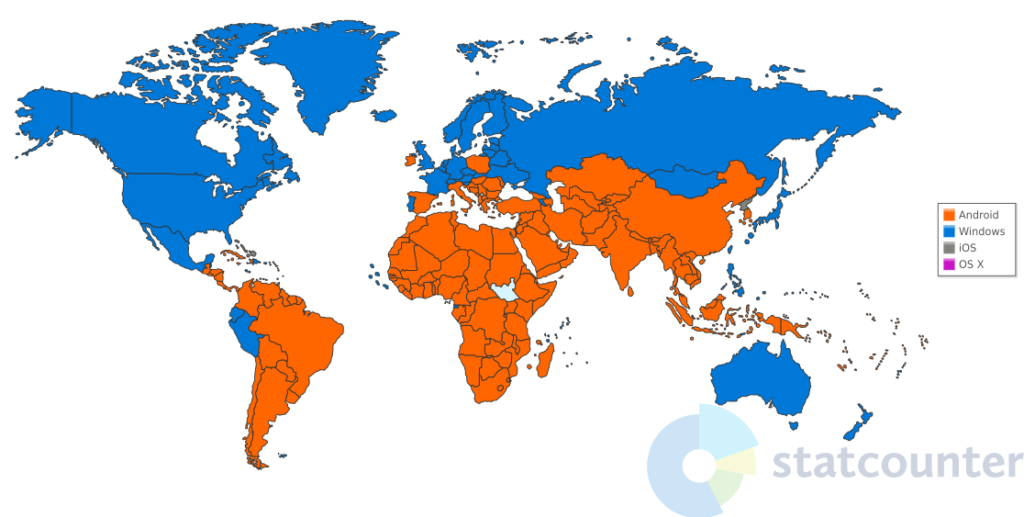As digital marketers, we have observed intriguing and contrasting trends while compiling reports for our clients: The proportion of desktop and mobile traffic from those who engage with some of our clients is nearly equal and for others, the number of mobile users surpasses that of desktop users by a significant amount. Intrigued by this – particularly because the devices used by our audience significantly impact how we shape our marketing campaigns – we set about to get answers.
However, during our research, we discovered that we were not alone in pondering this question, and the answer was not as straightforward as we had anticipated.
What are the official stats?
According to GobalStatscounter, in June 2023, 50.27% of global web visits were through mobile phones and 47.31% through desktops, with tablets and consoles accounting for the rest. When zooming in on the South African Statistics, the findings look a lot different, whereby mobile accounted for 73.52% and desktop 26.48% of web traffic.
Desktop vs Mobile Market Share Worldwide: May - June 2023

When considering the global map of the desktop and mobile market share, it is clear that mobile usage dominates in underdeveloped nations. This aligns with the 2022 data from the International Telecommunication Union (ITU), an agency within the United Nations: They found that mobile usage is higher in underdeveloped nations. “In most developing countries, mobile broadband (3G or above) is the main way — and often the only way — to connect to the Internet”.
Desktop & Operating System Worldwide Market Share: June 2022 - June 2023

When comparing the total OS market share of desktop and mobile (the usage share of operational systems), the map division looks nearly identical to the previous map. Android has the largest market share in many developing countries, compared to windows.
Looking at this market share distribution, it becomes evident that Android holds the largest portion of the market in numerous developing nations. In these developing countries, where mobile technology often serves as the primary means of accessing the internet and engaging with digital services, it is no surprise that a mobile based operating system such as Android is the preferred operating system.
On the other hand, an operating system primarily designed and optimized for desktop environments such as Windows maintains a prominent presence in developed countries. The developed world use more desktop devices due to established infrastructure and the need for more specialised software needed in more advanced economies.
The Leap Frog Effect
In recent years, there has been a noticeable surge in mobile usage, around the world. From June 2012 to June 2013, we can observe that global desktop usage accounted for 86.7%, while mobile usage accounted for 13.3% (50.27% in 2023). Even in South Africa, during this period, desktop usage stood at 79.1%, and mobile usage was at 20.99%. However, the landscape has rapidly evolved since then (mobile equates to 73.52% in 2023)
Desktop vs Mobile Market Share Worldwide: 2009 - 2023

In Africa, desktop stood at 84% between June 2012 – June 2013. But Desktop usage has fallen to 25.72% by 2023 and mobile now stands at 74.28%. These figures demonstrate the significant growth and impact of mobile technology in recent years.
This shift towards mobile in developing nations can be attributed to a fascinating phenomenon called the Leapfrog Effect. This phenomenon refers to the tendency of underdeveloped nations to bypass traditional development stages and directly adopt more advanced or innovative solutions.
Mobile devices has played an integral role in bridging the digital divide and providing access to online services and information in regions where traditional infrastructure might be lacking. Thus, although there is a global shift towards mobile use underdeveloped nations are showing a faster pace of adoption.
What does this mean for marketers?
For us marketers, it is important to note that consumers across the world are moving towards mobile phones to browse the internet. And, for South African and African marketers, it is fair to say that this move has already happened. But does this mean that we should ditch optimising our marketing efforts to Desktops? Not at all!
The Desktop vs Mobile divide is still extremely complex and it all depends on the context of your marketing campaigns. Lucky for us digital marketers, tools such as meta business and google analytics enables us to better understand our audiences devise preferences.
The desktop vs mobile divide can not be applied to everyone and is often industry specific. For instance, if you mainly use social media channels, it might be helpful to note that only 1.86% of desktop users use Instagram but that the numbers climbs to 10.63% for mobile users.
On the other hand, if you are designing a website for an international audience, you may need to take the nearly 50/50 divide of global web visits into account to ensure that your website is mobile and desktop friendly. And then again, when you are focussing on e-commerce for instance, your product is key to understanding device usage. Are you or your client selling food, jewellery or clothing? Younger individuals, who are more accustomed to mobile usage, find it convenient to make purchases on their mobile devices. On the other hand, the high end jewellery industry, which tends to cater to an older demographic, sees a higher proportion of desktop usage.
Therefore, the answer all depends on your product/service and audience demographic. So, take into account the following factors when tailoring your social media marketing efforts.
4 ways device preference affects your marketing efforts
Channel Selection
Desktop Users: When it comes to channel selection for desktop users, marketers can focus on strategies that are better suited for larger screens and traditional browsing experiences. This includes channels such as display advertising, email marketing, and website-based interactions. Marketers can invest in visually appealing banner ads, create engaging email campaigns, and optimize their websites for desktop users’ browsing preferences.
Mobile Users: For mobile users, marketers need to consider channels that align with the mobile-centric nature of their devices. This includes mobile app advertising and SMS marketing. Marketers can leverage the popularity of mobile apps by running targeted advertisements within popular mobile applications. They can also utilize SMS (Short Message Service) marketing to send personalized promotional messages directly to users’ mobile devices.
Targeting and personalisation
Desktop Users: When it comes to channel selection for desktop users, marketers can focus on strategies that are better suited for larger screens and traditional browsing experiences. This includes channels such as display advertising, email marketing, and website-based interactions. Marketers can invest in visually appealing banner ads, create engaging email campaigns, and optimize their websites for desktop users’ browsing preferences.
Mobile Users: For mobile users, marketers need to consider channels that align with the mobile-centric nature of their devices. This includes mobile app advertising and SMS marketing. Marketers can leverage the popularity of mobile apps by running targeted advertisements within popular mobile applications. They can also utilize SMS (Short Message Service) marketing to send personalized promotional messages directly to users’ mobile devices.
Targeting and Personalisation
Desktop Users: For desktop users, targeting and personalization can be based on device-specific data such as screen sizes, operating systems, or browsing behavior. Marketers can customize their messaging to address the unique needs and preferences of desktop users, highlighting features specific to their device or tailoring offers that resonate with their desktop browsing patterns.
Mobile Users: When targeting mobile users, marketers can leverage device-specific data like operating systems, app usage, or screen sizes. This information allows them to segment their audience and deliver targeted ads, messaging, and offers that are relevant to mobile users. By personalizing content based on the specific characteristics of mobile devices, marketers can increase engagement and conversions.
Content Adaptation
Desktop Users: Content adaptation for desktop users can focus on providing more detailed and immersive experiences. Marketers can create longer-form content, such as in-depth articles, videos, or interactive experiences, that take advantage of the larger screen space and higher bandwidth available on desktop devices. They can incorporate rich media elements, infographics, or interactive features to enhance the overall desktop user experience.
Mobile Users: Content adaptation for mobile users requires a focus on concise and easily scannable content. Marketers should optimize their content for mobile screens by breaking up text into shorter paragraphs, using subheadings, and bullet points, and incorporating visually appealing images. This ensures easy readability and a better user experience on smaller mobile screens.
User Experience Optimisation:
Desktop Users: For desktop users, user experience optimization can involve ensuring responsive web design, fast loading times, and intuitive navigation. Marketers should prioritize creating websites that adapt seamlessly to different screen sizes and resolutions, allowing desktop users to have a smooth and engaging browsing experience.
Mobile Users: User experience optimization for mobile users requires a mobile-first approach. Marketers should focus on responsive web design, mobile-friendly layouts, and touch-friendly interfaces. They need to ensure that their websites, ads, and content are optimized for mobile devices, providing a seamless and intuitive user experience on smaller screens with touch interfaces.
Conclusion
Android takes the lead in developing countries, while Windows remains a dominant force in desktop computing for developed nations. This shift towards mobile can be attributed to the fascinating Leapfrog Effect, where underdeveloped nations skip traditional stages of development and embrace advanced technologies.
For us marketers, it’s essential to understand our target audience’s device preferences. The desktop vs. mobile divide is complex and industry-specific. Factors like product or service nature and demographic preferences shape our marketing strategies.
We need to adapt our channels, targeting, content, and user experience to cater to both desktop and mobile users. Desktop strategies can focus on larger screens and traditional browsing experiences, while mobile strategies should align with mobile-centric behaviours.
The key takeaway? Tailor your marketing efforts based on your unique product or service and your audience’s device preferences. By doing so, you can maximize engagement and conversions across desktop and mobile platforms in this ever-connected digital world.


